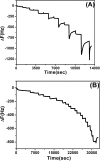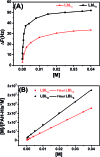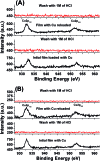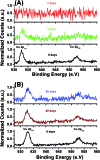Imprinting of metal receptors into multilayer polyelectrolyte films: fabrication and applications in marine antifouling
- PMID: 28966763
- PMCID: PMC5586206
- DOI: 10.1039/c4sc02367f
Imprinting of metal receptors into multilayer polyelectrolyte films: fabrication and applications in marine antifouling
Abstract
Polymeric films constructed using the layer-by-layer (LbL) fabrication process were employed as a platform for metal ion immobilization and applied as a marine antifouling coating. The novel Cu2+ ion imprinting process described is based on the use of metal ion templates and LbL multilayer covalent cross-linking. Custom synthesized, peptide mimicking polycations composed of histidine grafted poly(allylamine) (PAH) to bind metal ions, and methyl ester containing polyanions for convenient cross-linking were used in the fabrication process. Two methods of LbL film formation have been investigated using alternate polyelectrolyte deposition namely non-imprinted LbLA, and imprinted LbLB. Both LbL films were cross linked at mild temperature to yield covalent bridging of the layers for improved stability in a sea water environment. A comparative study of the non-imprinted LbLA films and imprinted LbLB films for Cu2+ ion binding capacity, leaching rate and stability of the films was performed. The results reveal that the imprinted films possess enhanced affinity to retain metal ions due to the preorganization of imidazole bearing histidine receptors. As a result the binding capacity of the films for Cu2+ could be improved by seven fold. Antifouling properties of the resulting materials in a marine environment have been demonstrated against the settlement of barnacle larvae, indicating that controlled release of Cu ions was achieved.
Figures












References
-
- Farhat T., Hammond P. T. Adv. Funct. Mater. 2005;15:945.
-
- Farhat T., Hammond P. T. Adv. Funct. Mater. 2006;16:433.
-
- Gu J. E., Lee S., Stafford C. M., Lee J. S., Choi W., Kim B. Y., Baek K. Y., Chan E. P., Chung J. Y., Bang J., Lee J. H. Adv Mater. 2013;25:4778. - PubMed
-
- Petty M. C. Stud. Interface Sci. 2002;16:317.
-
- Welterlich I., Tieke B. Macromolecules. 2011;44:4194.
LinkOut - more resources
Full Text Sources
Other Literature Sources
Research Materials

